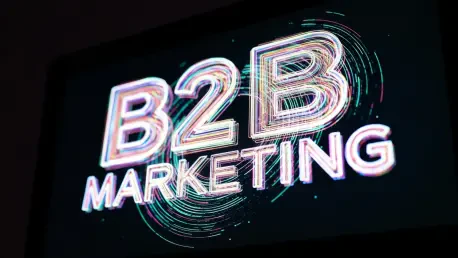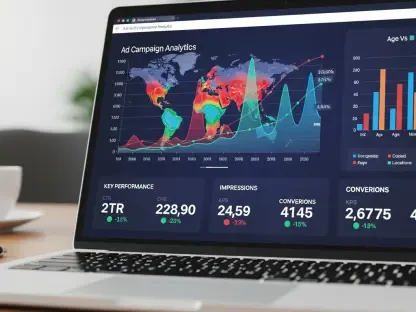In a high-stakes B2B product launch, a single misstep can cost millions and shatter brand credibility overnight, making the pressure to execute flawlessly more intense than ever. Picture a meticulously planned campaign unraveling due to a leaked detail or a message that fails to resonate with a complex buying group, while competitors stand ready to exploit any weakness. Enter digital twins—a cutting-edge technology that allows marketers to simulate every aspect of a launch in a risk-free virtual environment. This revolutionary approach is transforming how B2B marketing teams navigate the treacherous waters of product introductions, promising precision where chaos once reigned.
The significance of this shift cannot be overstated. Digital twins, originally developed for engineering to test physical systems, have emerged as a powerful tool in marketing, offering AI-powered replicas of audience segments, buyer journeys, and decision-making processes. Built on robust first-party data, these simulations enable teams to rehearse campaigns, identify blind spots, and refine strategies before going live. In an era where data-driven decisions are paramount, this technology addresses longstanding vulnerabilities in B2B launches, from security risks to misaligned messaging. The following exploration delves into why these tools are becoming indispensable for marketers aiming to stay ahead in a fiercely competitive landscape.
Why B2B Product Launches Face High Risks of Failure
B2B product launches operate in a pressure cooker of complexity and expectation. Unlike consumer markets, where individual buyers make swift decisions, B2B transactions often involve multiple stakeholders—economic buyers, technical gatekeepers, and legal approvers—each with distinct priorities. A single misaligned message can stall a deal or erode trust, leading to significant financial losses. Studies indicate that nearly 30% of B2B product launches fail to meet revenue targets due to poor execution or inadequate market understanding, highlighting the razor-thin margin for error.
Beyond messaging challenges, the risk of information leaks poses a constant threat. In a digital age where competitors can access sensitive data with alarming ease, a premature disclosure of pricing or features can undermine months of planning. The fallout from such breaches often extends beyond immediate revenue impact, damaging long-term partnerships and brand reputation. This vulnerability underscores the need for innovative solutions that can safeguard critical details while still allowing for thorough testing and preparation.
Moreover, the sheer cost of traditional launch preparation adds another layer of risk. Coordinating global focus groups, managing extensive feedback loops, and iterating on campaigns in real-world settings can drain budgets rapidly. When these efforts fail to yield actionable insights, the investment feels wasted, amplifying the stakes. These combined pressures create an urgent demand for a smarter, more secure approach to B2B marketing strategies.
Digital Twins Emerge as a Marketing Powerhouse
Digital twins have made a remarkable leap from their origins in engineering to the forefront of B2B marketing innovation. Initially designed to simulate physical assets like jet engines for stress testing, these virtual replicas now model intangible elements such as audience behaviors and buyer journeys with stunning accuracy. Powered by AI and fueled by first-party data, digital twins replicate real-world dynamics in a controlled digital space, offering marketers an unprecedented tool for precision planning.
The rise of this technology aligns with broader trends in data-driven decision-making. As competitive pressures intensify, the ability to predict outcomes and mitigate risks before a launch becomes a strategic advantage. Digital twins meet this need by allowing teams to explore countless scenarios without real-world consequences, a capability that traditional methods like surveys or focus groups cannot match. Their adoption reflects a growing recognition that intuition alone is insufficient in today’s fast-paced, high-stakes environment.
This shift also responds to the increasing complexity of marketing ecosystems. With buyers accessing information across diverse channels and platforms, crafting a cohesive launch strategy requires deep insight into fragmented decision-making processes. Digital twins provide a sandbox to test these variables, ensuring campaigns are robust and adaptable. Their emergence marks a new frontier where technology and marketing strategy converge to redefine success.
Core Benefits of Digital Twins for B2B Launches
One of the standout advantages of digital twins lies in their ability to enhance security during product launches. By moving early-stage testing into a sealed virtual environment, the risk of leaks—whether of pricing, features, or timelines—is drastically reduced. A cautionary example is Epic Games’ Fortnite “black hole” event, where a breach by a contracted playtester disrupted a carefully orchestrated campaign. Digital twins eliminate such human-related vulnerabilities, protecting sensitive information from premature exposure.
Another critical benefit is addressing audience fatigue, a persistent issue in traditional testing. Repeatedly engaging the same focus groups can degrade the quality of feedback as respondents grow weary or overly familiar with concepts. Digital twins allow for endless iterations without taxing real audiences, reserving human input for final validation. This approach ensures insights remain fresh and reliable while also accelerating the testing timeline significantly.
Cost efficiency further solidifies the value of this technology. Organizing multiple global focus groups or real-world trials often incurs staggering expenses, sometimes running into hundreds of thousands of dollars. In contrast, virtual simulations offer comparable depth at a fraction of the cost, enabling more iterations and greater confidence in the final strategy. Additionally, digital twins excel at modeling the nuances of B2B buying groups, simulating diverse stakeholder reactions to refine messaging for maximum impact. This multifaceted utility makes them a transformative asset for launch planning.
Industry Voices on the Impact of Digital Twins
Expert perspectives lend significant weight to the growing adoption of digital twins in marketing. McKinsey describes these tools as contextualized digital replicas that enhance organizational decision-making by mirroring real-world environments with precision. This framing underscores their role not just as simulators but as strategic enablers, helping teams anticipate outcomes with greater clarity. Such insights are proving invaluable in high-pressure contexts like B2B launches.
Further validation comes from Panoplai, which emphasizes the grounding of digital twins in authentic data. By capturing real language, emotions, and sentiments, these simulations deliver both quantitative metrics and qualitative depth, ensuring outputs are not speculative but predictive. This reliability distinguishes digital twins from less rigorous modeling approaches, offering marketers a trustworthy foundation for campaign adjustments.
Companies like Mod Op are also integrating digital twins into proprietary analytics toolsets, viewing them as accelerators rather than replacements for existing methods. Industry anecdotes reveal a surge in simulation-based strategies, with many firms reporting reduced launch risks and improved stakeholder alignment. One marketing executive noted that virtual testing exposed messaging gaps that would have been missed in traditional focus groups, illustrating the practical impact of this technology. These voices collectively affirm that digital twins are reshaping how the industry approaches complex challenges.
Practical Steps to Leverage Digital Twins in Marketing
For B2B marketing teams eager to harness digital twins, the starting point is constructing a robust virtual model using first-party data. This involves mapping audience segments, buyer journeys, and decision-making patterns to create a lifelike replica of the target market. Such a foundation ensures simulations reflect real-world dynamics, providing a solid basis for testing launch components like messaging or channel selection.
Once the digital twin is built, running “what if” scenarios becomes a powerful next step. Marketers can experiment with various creative approaches, pricing strategies, or rollout timelines in a risk-free space, identifying potential pitfalls before they manifest. This iterative process allows for fine-tuning campaigns to address the specific needs of diverse B2B stakeholders, from technical evaluators to financial decision-makers, without the constraints of real-world testing limitations.
A final practical tip is to balance virtual and real-world efforts strategically. While simulations handle the bulk of early experimentation, reserving human feedback for late-stage validation preserves audience engagement and ensures final adjustments are grounded in authentic responses. By aligning insights from digital twins with the nuanced demands of buying groups, teams can craft launches that are not only polished but also precisely targeted. This structured approach maximizes the technology’s potential to de-risk and elevate campaign outcomes.
Reflecting on a Transformative Shift
Looking back, the integration of digital twins into B2B marketing marked a pivotal moment in how product launches were approached. This technology provided a secure haven to test strategies, shielding sensitive details from leaks while slashing the costs tied to traditional methods. The ability to simulate complex buying group dynamics with uncanny accuracy helped countless teams avoid missteps that once derailed campaigns.
Beyond immediate wins, the journey with digital twins revealed a broader lesson about embracing innovation. Marketers who adapted early gained a competitive edge, navigating high-stakes environments with newfound confidence. For those yet to explore this tool, the next step was clear: invest in building robust data foundations to power these simulations, ensuring relevance and reliability.
As the landscape continued to evolve, staying ahead demanded a willingness to experiment with such cutting-edge solutions. Teams were encouraged to partner with technology providers or internal data experts to integrate digital twins seamlessly into existing workflows. This proactive stance promised not just safer launches but a deeper understanding of market intricacies, paving the way for sustained success in an ever-competitive arena.









